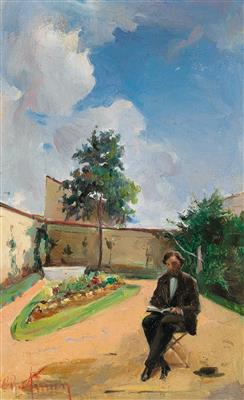Theodor Aman

(Câmpulung Muscel 1831–1891 Bucharest)
The painter in the inner courtyard, signed Th. Aman, on the reverse a bouquet of flowers, oil on panel, 16 x 10 cm, framed (frame damaged), (Rei)
Provenance:
Private Collection Austria.
We are grateful to Angelica Iacob and Greta Suteu, Theodor Aman Museum Bucharest, for the scientific assistance..
Theodor Aman is an important representative of Romanian art of the 19th century and one of the founding fathers of the School of Fine Arts in Bucharest (now the Institul de Arte Plastice ‘Nicolae Grigorescu’). He completed his early artistic training in Craiova, a city in southwest Romania, before continuing his studies in Paris in around 1850. He was at times in contact with revolutionary Romanian circles, to which he remained connected during his stay in Paris. In 1853 he made his debut at the Paris Salon with a self-portrait, in which he oriented himself towards Gustave Courbet. Portraits were an essential genre throughout his artistic career, to which he devoted himself time and again. The following year he travelled to Constantinople, where he was received by the sultan, who acquired a painting by Aman. After a stay in his homeland, he travelled to Rome, Venice and Milan after receiving the title of boyar, combined with a scholarship for further study trips. After his return, he finally settled down in 1858 in Bucharest, but this did not prevent him from taking several trips to France and Belgium in later years. From 1859, he campaigned for the establishment of a school of fine arts in Bucharest, which was finally opened in 1864. He served as its director until his death, and taught painting with Gheorghe Tattarescu (1814-1894). With the affiliated painting collection, they laid the foundation of the national art collection in Bucharest, promoted young Romanian artists and in 1865 organised the first exhibition of living artists in Romania. Aman brought about the raising of the social status of the artists in his homeland and was the first Romanian painter to depict current events.
His paintings are inspired by French Orientalism as well as contemporary battle painting, which he discovered in Paris. He devoted himself to the depiction of sophisticated life but also the diversity of genre painting. An essential branch of his work, however, were portraits, including a variety of self-portraits, such as the present lot. It seems that Aman has depicted himself in the garden of his house, which today is the Theodor Aman Museum in Bucharest. Immersed in a book, the painter lingers in his garden and the picture conveys the mood of a pleasant sunny day. Its colourful freshness suggests the influence of French plein-air painting. The work may well be part of a series of wood panels painted on both sides, such that the reverse displays a blooming bouquet of flowers, which is filled with a sensitive spontaneity.
Esperta: Mag. Dimitra Reimüller
 Mag. Dimitra Reimüller
Mag. Dimitra Reimüller
+43-1-515 60-355
19c.paintings@dorotheum.at
29.04.2019 - 17:00
- Stima:
-
EUR 10.000,- a EUR 14.000,-
Theodor Aman
(Câmpulung Muscel 1831–1891 Bucharest)
The painter in the inner courtyard, signed Th. Aman, on the reverse a bouquet of flowers, oil on panel, 16 x 10 cm, framed (frame damaged), (Rei)
Provenance:
Private Collection Austria.
We are grateful to Angelica Iacob and Greta Suteu, Theodor Aman Museum Bucharest, for the scientific assistance..
Theodor Aman is an important representative of Romanian art of the 19th century and one of the founding fathers of the School of Fine Arts in Bucharest (now the Institul de Arte Plastice ‘Nicolae Grigorescu’). He completed his early artistic training in Craiova, a city in southwest Romania, before continuing his studies in Paris in around 1850. He was at times in contact with revolutionary Romanian circles, to which he remained connected during his stay in Paris. In 1853 he made his debut at the Paris Salon with a self-portrait, in which he oriented himself towards Gustave Courbet. Portraits were an essential genre throughout his artistic career, to which he devoted himself time and again. The following year he travelled to Constantinople, where he was received by the sultan, who acquired a painting by Aman. After a stay in his homeland, he travelled to Rome, Venice and Milan after receiving the title of boyar, combined with a scholarship for further study trips. After his return, he finally settled down in 1858 in Bucharest, but this did not prevent him from taking several trips to France and Belgium in later years. From 1859, he campaigned for the establishment of a school of fine arts in Bucharest, which was finally opened in 1864. He served as its director until his death, and taught painting with Gheorghe Tattarescu (1814-1894). With the affiliated painting collection, they laid the foundation of the national art collection in Bucharest, promoted young Romanian artists and in 1865 organised the first exhibition of living artists in Romania. Aman brought about the raising of the social status of the artists in his homeland and was the first Romanian painter to depict current events.
His paintings are inspired by French Orientalism as well as contemporary battle painting, which he discovered in Paris. He devoted himself to the depiction of sophisticated life but also the diversity of genre painting. An essential branch of his work, however, were portraits, including a variety of self-portraits, such as the present lot. It seems that Aman has depicted himself in the garden of his house, which today is the Theodor Aman Museum in Bucharest. Immersed in a book, the painter lingers in his garden and the picture conveys the mood of a pleasant sunny day. Its colourful freshness suggests the influence of French plein-air painting. The work may well be part of a series of wood panels painted on both sides, such that the reverse displays a blooming bouquet of flowers, which is filled with a sensitive spontaneity.
Esperta: Mag. Dimitra Reimüller
 Mag. Dimitra Reimüller
Mag. Dimitra Reimüller
+43-1-515 60-355
19c.paintings@dorotheum.at
|
Hotline dell'acquirente
lun-ven: 10.00 - 17.00
kundendienst@dorotheum.at +43 1 515 60 200 |
| Asta: | Dipinti dell’Ottocento |
| Tipo d'asta: | Asta in sala |
| Data: | 29.04.2019 - 17:00 |
| Luogo dell'asta: | Wien | Palais Dorotheum |
| Esposizione: | 20.04. - 29.04.2019 |
Altri oggetti dell'artista
-

Stima:
EUR 15.000,- a EUR 25.000,-
